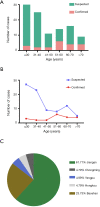The epidemiologic and clinical features of suspected and confirmed cases of imported 2019 novel coronavirus pneumonia in north Shanghai, China
- PMID: 32566574
- PMCID: PMC7290637
- DOI: 10.21037/atm-20-2119
The epidemiologic and clinical features of suspected and confirmed cases of imported 2019 novel coronavirus pneumonia in north Shanghai, China
Abstract
Background: A recent cluster of pneumonia cases in Wuhan (China) is known to be caused by a novel beta-coronavirus named the corona virus disease 2019 (COVID-19) and can be spread through human-to-human transmission.
Methods: Data of 21 patients with laboratory-confirmed COVID-19 and 84 patients with suspected COVID-19 were analyzed by RT-PCR. The epidemiologic and clinical features as well as clinical outcomes were compared between the confirmed and suspected cases.
Results: Altogether 105 patients had been enrolled in this study by February 15, 2020 in north Shanghai, including 21 confirmed cases and 84 suspected cases of COVID-19. The incubation period of these confirmed patients with imported COVID-19 was 17.6 days (IQR 5-34 days) and the median time from symptom onset to diagnosis was 145.64 h (IQR 21-441 h). More than 50% of the confirmed patients were older than 51 (range, 51-60) years. Fifty (59.5%) of the 84 probably patients were younger than 40 years, including 27 (32%) patients younger than 30 years. Most confirmed patients were men (61.9%, 13/21), and less than 50% of them had underlying diseases, including diabetes (9.5%, 2/21), hypertension (19%, 4/21), COPD (23.8%, 5/21), and CD (23.8%, 5/21). In addition, 10 (47.6%) of the 21 confirmed patients were ordinary employees, and 12 (57.2%) of them had recently been to Wuhan or had close contacts with people from Wuhan. Of the 84 suspected patients, 28 (33.3%) were retired employees; 69 (82.1%) had recently been to supermarkets and groceries or had a history of traveling abroad or to other cities of China. The common onset symptoms of the patients in both groups were fever and cough. The symptom of Sputum production was more pronounced in probably patients (40.5%, 34/84) than that in confirmed patients (9.5%, 2/21). More than 50% imported patients (53.3%, 56/105) had one and two affected lobes. Twenty-nine (27.6%) of the 105 imported patients had been discharged, no patient had died, and all the other patients are still in hospital.
Conclusions: The overall incubation period in this cohort of imported confirmed COVID-19 patients was longer than that in Wuhan, mostly infecting older men. The disease onset of imported COVID-19 infection was occult, and the clinical symptoms were usually mild, mostly presenting as low fever, fatigue, light cough, and mild dyspnea.
Keywords: Coronavirus infections; computed tomographic findings; imported; incubation period; pneumonia; symptoms.
2020 Annals of Translational Medicine. All rights reserved.
Conflict of interest statement
Conflicts of Interest: All authors have completed the ICMJE uniform disclosure form (available at http://dx.doi.org/10.21037/atm-20-2119). The authors have no conflicts of interest to declare.
Figures






References
-
- WHO. Novel coronavirus–China. Jan 12, 2020. Available online: http://www.who.int/csr/don/12-january-2020-novel-coronavirus-china/en/ (accessed Jan 19, 2020).
-
- WHO. Novel coronavirus–Thailand (ex-China). Jan 14, 2020. http://www.who.int/csr/don/14-january-2020-novel-coronavirus-thailand/en/ (accessed Jan 19, 2020).
LinkOut - more resources
Full Text Sources
